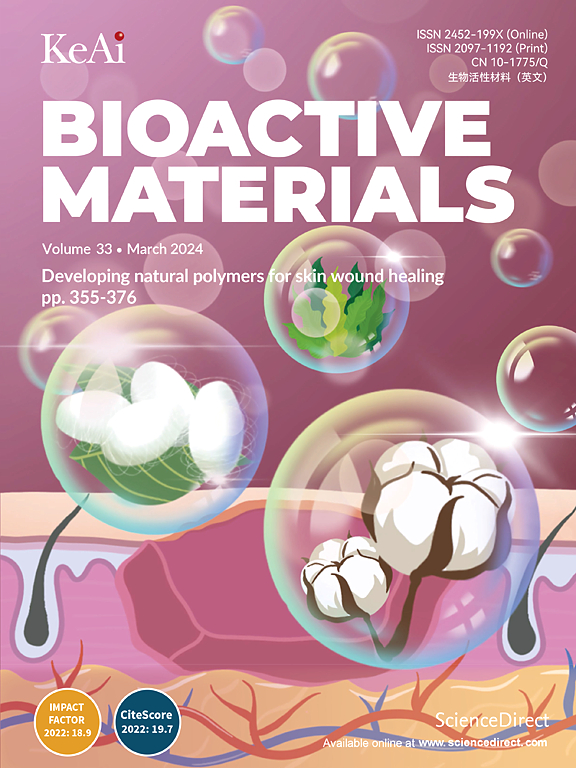Microenvironment-responsive coating for vascular stents to regulate coagulation-inflammation interaction and promote vascular recovery
IF 18
1区 医学
Q1 ENGINEERING, BIOMEDICAL
引用次数: 0
Abstract
Early coagulation-inflammation interaction and late in-stent restenosis undermine the efficacy of vascular stents after implantation. Targeting the interplay between inflammation and coagulation, and smooth muscle cell (SMC) proliferation, we presented a microenvironment-responsive coating designed to regulate tissue responses and vascular regeneration throughout the remodeling process. Coagulation was inhibited by incorporating anticoagulant tirofiban into the coating. MMP9-responsive nanoparticles embedded in the coating released salvianolic acid A to modulate inflammatory cell behavior and inhibit SMC dysfunction. By effectively interfering with clotting and inflammation, the coating suppressed platelet-fibrin interaction and formation of platelet-monocyte aggregates, thereby mitigating adverse effects on reendothelialization. Its ability to influence SMC proliferation and migration resulted in reduced intimal hyperplasia. Coated stents were shown to significantly regulate tissue regeneration, improve the vascular environment and even reduced the lipid content in the narrowed atherosclerotic vessels in vivo. This direct approach enhanced the vascular tissue regeneration after stent implantation, and offered promising insights for optimizing vascular stent design.

血管支架微环境响应涂层调节凝-炎症相互作用,促进血管恢复
早期的凝血-炎症相互作用和晚期的支架内再狭窄影响了血管支架植入后的疗效。针对炎症、凝血和平滑肌细胞(SMC)增殖之间的相互作用,我们提出了一种微环境响应涂层,旨在调节组织反应和血管再生。在涂层中加入抗凝剂替罗非班可抑制凝血。mmp9响应纳米颗粒嵌入涂层中,释放丹酚酸A,调节炎症细胞行为,抑制SMC功能障碍。通过有效地干扰凝血和炎症,涂层抑制了血小板-纤维蛋白的相互作用和血小板-单核细胞聚集体的形成,从而减轻了对再内皮化的不利影响。其影响SMC增殖和迁移的能力导致内膜增生减少。涂层支架在体内可显著调节组织再生,改善血管环境,甚至降低狭窄动脉粥样硬化血管的脂质含量。这种直接的方法增强了支架植入后血管组织的再生,为优化血管支架设计提供了有希望的见解。
本文章由计算机程序翻译,如有差异,请以英文原文为准。
求助全文
约1分钟内获得全文
求助全文
来源期刊

Bioactive Materials
Biochemistry, Genetics and Molecular Biology-Biotechnology
CiteScore
28.00
自引率
6.30%
发文量
436
审稿时长
20 days
期刊介绍:
Bioactive Materials is a peer-reviewed research publication that focuses on advancements in bioactive materials. The journal accepts research papers, reviews, and rapid communications in the field of next-generation biomaterials that interact with cells, tissues, and organs in various living organisms.
The primary goal of Bioactive Materials is to promote the science and engineering of biomaterials that exhibit adaptiveness to the biological environment. These materials are specifically designed to stimulate or direct appropriate cell and tissue responses or regulate interactions with microorganisms.
The journal covers a wide range of bioactive materials, including those that are engineered or designed in terms of their physical form (e.g. particulate, fiber), topology (e.g. porosity, surface roughness), or dimensions (ranging from macro to nano-scales). Contributions are sought from the following categories of bioactive materials:
Bioactive metals and alloys
Bioactive inorganics: ceramics, glasses, and carbon-based materials
Bioactive polymers and gels
Bioactive materials derived from natural sources
Bioactive composites
These materials find applications in human and veterinary medicine, such as implants, tissue engineering scaffolds, cell/drug/gene carriers, as well as imaging and sensing devices.
 求助内容:
求助内容: 应助结果提醒方式:
应助结果提醒方式:


